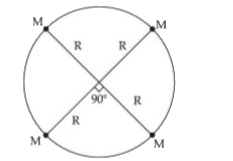A particle moves in a circular orbit under the action of a central attractive force inversely proportional to the distance r. The speed of the particle is
A
proportional to r2
B
independent of r
C
proportional to r
D
proportional to 1/r
Video Solution
|
Answer
Step by step video & image solution for A particle moves in a circular orbit under the action of a central attractive force inversely proportional to the distance r. The speed of the particle is by Physics experts to help you in doubts & scoring excellent marks in Class 11 exams.
Updated on:21/07/2023
Related Playlists
Knowledge Check
- Question 1 - Select One
A particle moves in a circular orbit under the action of a central attractive force which is inversely proportional to the distance 'r' . The speed of the particle is
Aproportional to r2BIndependent of rCproportional to rDproportional to 1/r - Question 1 - Select One
A particle moves in a circular orbit under the action of a central attractive force inversely proportional to the distance r. The speed of the particle is
AProportional to r2BIndependent of rCProportional to rDProportional to 1/r - Question 1 - Select One
A particle executes circular motion under a central attractive force inversely proportional to distance R. The speed of the particle is
ADependent on RBDependent on R2CIndependent of RDDependent on 1/R - Question 1 - Select One
A particle revolves round a circular path. The acceleration of the particle is inversely proportional to-
AradiusBvelocityCmass of particleDboth (b) & (c) - Question 1 - Select One
A particle is moving with a uniform speed in a circular orbit of radius R in a central force inversely proportional to the nth power of R. If the period of rotation of the particle is T, then :
AT∝Rn/2BT∝R3/2 for any n.CT∝Rn2+1DT∝R(n+1)/2 - Question 1 - Select One
A particle revolves round a circular path. The acceleration of the particle is inversely proportional
ARadiusBVelocityCMass of particle,DBoth (2) and (3) - Question 1 - Select One
A particle revolves around a circular path. The centripetal acceleration of the particle is inversely proportional to
Aradius of pathBMass of particleCspeed of particleDboth (2) and (3) - Question 1 - Select One
A particle is moving in a circular path of radius r under the action of a force F. If at an instant velocity of particle is v, and speed of particle is increasing, then
A→F.→v=0B→F.→c>0C→F.→v<0D→F.→v≥0 - Question 1 - Select One
A particle is moving with uniform speed along the circumference of a circle of radius R under the action of a central fictitious force F which is inversely proportional to R3. its time period of revolution will be given by :
AT∝R2BT∝R32CT∝R52DT∝R43


